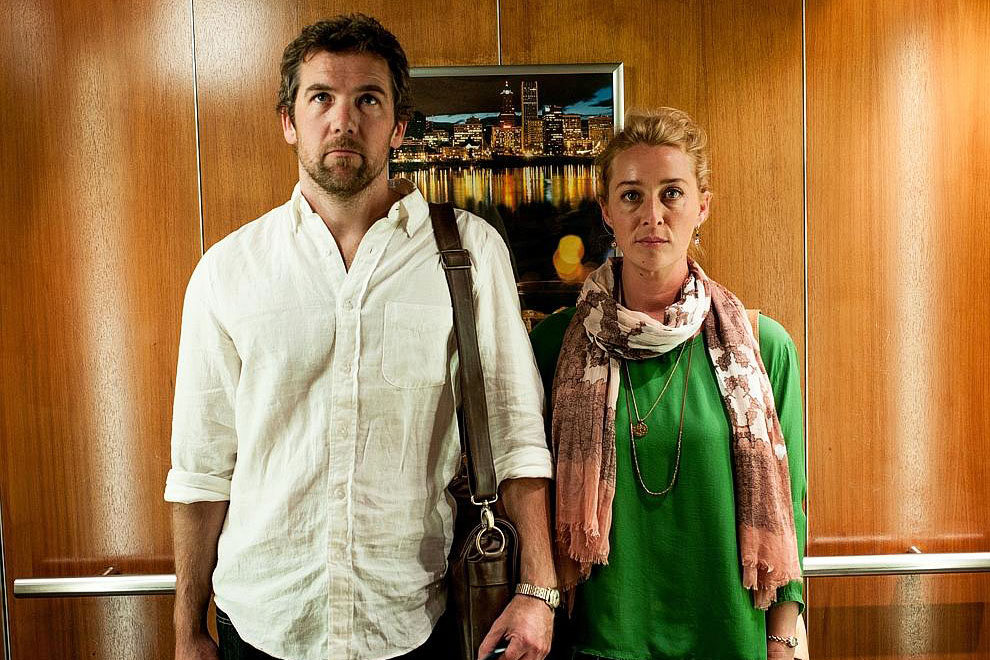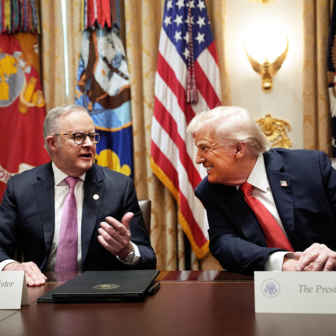On 7 August this year 1.3 million people watched what is probably the last episode of the popular Australian series Offspring. Created by Debra Oswald and produced by John Edwards, Offspring started life as a telemovie but was spun out into five series from 2010. It has consistently been in the top ten Australian dramas for each year and its star, Asher Keddie, has twice won the most popular actress Logie and once the Gold Logie for her work in the show.
The series has been a bright spot for the struggling Ten Network and clearly has a loyal fan base. But because it is likely to be at least 20 per cent more expensive to make, it will probably not return in 2015. And that’s because the program will no longer be eligible for tax incentives available from the Australian government.
Offspring is one of the series Ten has screened as part of its obligation to show new Australian drama under the Australian Content Standard for commercial television. All networks are required to transmit Australian programs for 55 per cent of the time between 6 am and midnight each day, and there are sub-quotas for first-release Australian drama, documentary and children’s programs.
A little over a week before the finale of Offspring, the Australian Communications and Media Authority released its report on the networks’ compliance with the standard in 2013. Each of them met the requirements for the overall transmission quota and for the sub-quotas, but the Nine Network met its first-release drama quota by broadcasting – as the rules allow – sixty-two hours of drama made in New Zealand.
Two questions are immediately obvious. Why did a popular show Ten uses to meet its drama content requirements need investment by the government to continue, or even to get made in the first place? And, over at Nine, how can a regulation designed to promote commercial television’s role “in developing and reflecting a sense of Australian identity, character and cultural diversity” be met by the television drama of another culture? The clues lie in the way drama programs are financed in Australia and the growing impact of trade agreements on cultural policy.
The program market and the funding mix
The production of Australian free-to-air drama series like Offspring is subject to a degree of what economists call market failure. Without some form of intervention by government, the program supply market could not afford to supply broadcasters with as much Australian drama as viewers might demand. Free-to-air broadcasters draw their supply of programs from what they are able to produce for themselves (such as news, current affairs and sport), what they can purchase from distributors of international programs (such as US and British drama, comedy and documentary) and what they can commission from independent local producers (such as drama, documentary, and kids and reality shows). The market failure arises when Australian programming not only can be replaced by imported programming but also is more expensive to produce than imports.
Programming that can’t be replaced by imports falls into two categories. In the first are programs that can’t be produced anywhere else because of their content, such as news broadcasts and coverage of local sport. Even big international sporting events like the World Cup or the Olympic Games are repackaged with an Australian feel for Australian viewers. In the second category are reality and “shiny floor” event television, both of which have been in vogue recently. Some of these programs may be based on imported formats but they are often produced in Australia for an Australian audience. Programs such as My Kitchen Rules, The Voice, The Block, The X Factor, Master Chef and Big Brother are expensive to produce, but can’t really be replaced by foreign versions, which would not attract the same large audiences or advertising revenues.
As viewing options expand in a multichannel, multiplatform world, these “non-substitutable” programs are a key part of the strategy of free-to-air broadcasters to retain viewers. Exclusive live sport and event television marks a huge point of difference and attracts viewers in large numbers. The large audiences attracted by live coverage of the weekly matches and grand finals of the two major football codes, for instance, provides an incentive for the commercial networks to pay the full cost of production. The 2013 finale of My Kitchen Rules was watched by 3.2 million people.
In recent years Australian drama has enjoyed renewed popularity, with programs like Packed to the Rafters, A Place to Call Home, House Husbands, Offspring, Miss Fisher’s Murder Mysteries and The Dr Blake Mysteries attracting good audiences. But these series still need to compete with imported drama. In 2011 Screen Australia reported that the average cost of an Australian one-hour drama was between $400,000 and $1.8 million; of that figure, the broadcaster might pay $350,000 to $1.4 million, compared to the $100,000 to $400,000 it pays for the rights to broadcast an episode of a US drama.
The fact that the cost of producing a television program is not directly related to the number of viewers is particularly evident for drama. Equally, adding new viewers to the audience, or adding new markets, does not affect the original cost of production or the price that can be charged to international broadcasters. For example, among the most popular foreign dramas on free-to-air television in 2013 was Downton Abbey. Although the average per-episode cost of production was reportedly £1 million (about A$1.8 million), the Seven Network would have paid a fraction of that cost for Australian broadcast rights. Once the original cost of production of the series had been financed, the marginal cost of reproduction meant that the price could be adjusted according to the ability of buyers in each national market to pay.
Most Australian television drama is made by independent producers (the exceptions are the Seven Network and the ABC, which produce some of their own drama) and is paid for by a mixture of public and private funding. The private funding comes from the broadcasters in the form of a licence fee and equity investment. In commissioning from an independent producer, the licence fee and the nature of the rights acquired by the broadcaster are a matter of negotiation. Private funding may also come from presales to international broadcasters, or investment and advances from international sales agents and distributors.
The public contribution recognises both the risk involved and the extent of market failure in the production of Australian television drama. It comes from two sources: investment by Screen Australia and state government screen agencies, and through the tax relief provided by the Producer Offset. Screen Australia’s investment in television drama is conditional on the local broadcaster (or subscription TV service) paying a minimum fee of $440,000 an hour, exclusive of any further investment, for Australian rights only. Screen Australia will only fund independent producers, which in practice tends to favour miniseries, telemovies and higher budget series.
The Producer Offset is a rebate of 20 per cent on what is called “qualifying Australian production expenditure.” It is paid by the Tax Office to the producer after the program has been made and a claim has been certified by Screen Australia. Productions need to meet a test of significant Australian content, which essentially means the program is under Australian creative control. The timing of the offset payment means that, since it is usually part of the financing plan for the production, the producer needs to be able to cover the cash flow or borrow from a financial institution to underwrite it. Alternatively, a producer might reduce its equity by sharing the offset payment with another party.
In recognition of the fact that drama series can last for a number of years (Neighbours and Home and Away have been running for twenty-nine and twenty-six years respectively) support from the offset cuts out after sixty-five commercial hours. A series that has run this long, the argument goes, should be able to continue without support from the tax system. This is the dilemma facing the producers of Offspring. Having reached sixty-five hours, do they proceed with another, more costly series?
Culture and trade
As this system of quotas and subsidies shows, Australian governments have placed considerable importance on fostering a television system that reflects national culture. Yet Australia’s participation in recent international trade agreements is pushing in the opposite direction, constraining the power of governments to act in this important area of cultural policy.
When television started in Australia in 1956 it was widely assumed, not least by the first broadcasters, that programs would predominantly be Australian in origin and character. But the introduction of television coincided with the increased availability of mainly American television shows, shot on film, which proved to be very popular with Australian audiences. Concern that Australian commercial television was losing its Australian character led to the first Australian content regulation in 1960. The policy rationale was to support the presentation of Australian culture on screen. The ABC had a remit to do this, but it had not been built into the rules governing commercial broadcasters.
The elements of this regulation have changed since then, but the cultural imperative – that commercial television should reflect a sense of Australian identity, character and cultural diversity by broadcasting programs made under Australian creative control – has not. There is broad political agreement about the need for this regulation, and the broadcasters have generally been able to fulfil their obligations. In contrast, the ability of countries like Australia to implement such cultural regulation is far from agreed in the context of international trade policy and regulation. What is more, it has been challenged by two of our trading partners, first New Zealand and then the United States, in the context of bilateral trade agreements.
The object of agreements like these, whether they are multilateral, plurilateral or bilateral, is to remove barriers to trade. Since the commencement in 1986 of the Uruguay Round of multilateral trade negotiations, which led to the formation of the World Trade Organization in 1995 and the extension of trade liberalisation to services, there has been no doubt that local content regulations amount to a barrier to free trade. The question has been what to do about it.
Before consensus was reached on the General Agreement on Trade in Services, or GATS, the negotiations on audiovisual services saw considerable disagreement between the United States, which was pushing for complete liberalisation, and the European Union nations, led by France, which refused to forfeit their ability to intervene in support of domestic industries. The Europeans didn’t achieve the exemption for cultural industries they were seeking, and the United States won agreement that audiovisual trade would be covered by the GATS and included in future negotiations, with the object of progressive liberalisation. The compromise is that the GATS is structured so that countries have to make offers to liberalise. In the audiovisual sphere, Australia has made no offers but the United States and New Zealand have.
The dispute with New Zealand has its origins back in 1983, when it entered into the Closer Economic Relations, or CER, trade agreement with Australia, which was extended in 1989 by a trade-in-services protocol. The effect was to liberalise all services trade between the two countries. At the time the screen production sector in Australia wasn’t paying much attention to the impact of trade agreements on cultural policies, but when the GATS was being settled that awareness had grown.
In 1996 an NZ screen sector group took the Australian Broadcasting Authority to court over its failure to recognise NZ programming in the Australian Content Standard. New Zealand is one of Australia’s largest audiovisual export markets and the NZ industry believed that by removing this trade impediment, trans-Tasman program flows might be equalised. Ultimately the challenge was successful and in 1998 the Australian High Court ordered a revision of the standard so that it was consistent with the CER.
At first the commercial broadcasters didn’t show much interest in taking advantage of this change, claiming that Australians generally were not interested in NZ programming. But over the past decade, according to figures published by the Australian Communications and Media Authority, the amount of NZ programming has risen from an annual four hours to 360 hours. In 2013 the amount of NZ drama shown in Australia to comply with the standard was seventy-five hours out of a total of 462 hours. If this trend continues then the risk involved in mounting an Australian drama project will increase, as will the pressure on Australia to liberalise in other trade negotiations.
For the United States, it was the slow progress on the Doha Round of multilateral trade negotiations, which had begun in 2001, that indirectly led to friction with Australia over local content rules. The problems with Doha had reinforced the Bush administration’s resolve to pursue bilateral and regional agreements as a means of creating a new international agenda for free trade. A principal attraction of these agreements is that they include standards of trade liberalisation that are higher than has been achieved in the GATS, which proved to be the case when Australia negotiated a free-trade agreement with the United States during 2003.
The US negotiators took the view that existing TV content quotas could remain but should not be extended to the digital realm. When the Australia–US Free Trade Agreement was announced in February 2004 Australia had managed to make a reservation for local content regulation for free-to-air television, but on the condition that quotas would be wound back if the Australian Content Standard is amended at any time. Reservations were also made for an increase in the expenditure requirements for Australian drama on subscription TV drama channels from 10 per cent to 20 per cent, and for up to two of any new channels provided by free-to-air broadcasters to be subject to local content requirements. In relation to interactive audio or video services, the Australian government must not only satisfy itself that it is necessary to enact regulatory measures, but also consult the government of the United States.
All of this means that cultural policy and trade policy have become inextricably linked. Ten years after the Australia–US Free Trade Agreement, Australia and the United States are again at the negotiating table as parties to the Trans-Pacific Partnership Agreement and the Trade in Services Agreement. It is unlikely that an exception for audiovisual services will be made in either. For the screen production sector, it then becomes a question of how far Australia can resist demands to give up more than it agreed to a decade ago. •




